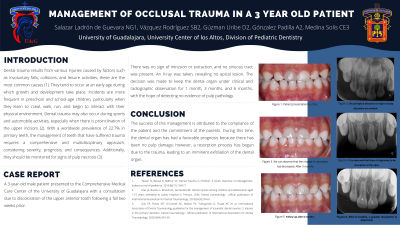Trauma
348 - Management Of Occlusal Trauma In a 3 Year Old Patient

- NS
Natalia Guadalupe Salazar Ladrón de Guevara (she/her/hers)
Resident of pediatric dentistry
University of Guadalajara
Universidad de Guadalajara
Tepatitlán de Morelos, Jalisco, Mexico - AG
Alberto González Padilla, n/a
University of Guadalajara
- CM
Carlo Eduardo Medina Padilla, n/a
University of Guadalajara
- DG
Daniela Guzmán Uribe, n/a
University of Guadalajara
- RS
Rodríguez Sandra Berenice, University of Guadalajara, Pediatric Dentistry
Professor
Universidad de Guadalajara
Tepatitlan de Morelos, Jalisco, Mexico - CA
Carmen Celina Alonso Sánchez, University of Guadalajara, Pediatric Dentistry
Program director
Universidad de Guadalajara
Tepatitlan de Morelos, Jalisco, Mexico
Presenting Author(s)
Co-Author(s)
Research Mentor(s)
Program Director(s)
Introduction: Dental trauma results from various injuries caused by factors such as involuntary falls, collisions, and leisure activities; these are the most common causes (1). They tend to occur at an early age during which growth and development take place. Incidents are more frequent in preschool and school-age children, particularly when they learn to crawl, walk, run, and begin to interact with their physical environment. Dental trauma may also occur during sports and automobile activities, especially when there is proinclination of the upper incisors (2). With a worldwide prevalence of 22.7% in primary teeth, the management of teeth that have suffered trauma requires a comprehensive and multidisciplinary approach, considering severity, prognosis, and consequences. Additionally, they should be monitored for signs of pulp necrosis (3).
Case Report: A 3-year-old male patient presented to the Comprehensive Medical Care Center of the University of Guadalajara with a consultation due to discoloration of the upper anterior tooth following a fall two weeks prior. In intraoral examination, dyschromia was observed in dental organ 51, with no pain on percussion and grade 1 mobility. There was no sign of intrusion or extraction, and no sinuous tract was present. An X-ray was taken, revealing no apical lesion. The decision was made to keep the dental organ under clinical and radiographic observation for 1 month, 3 months, and 6 months, with the hope of detecting no evidence of pulp pathology.
Identify Supporting Agency and Grant Number:

.jpg)